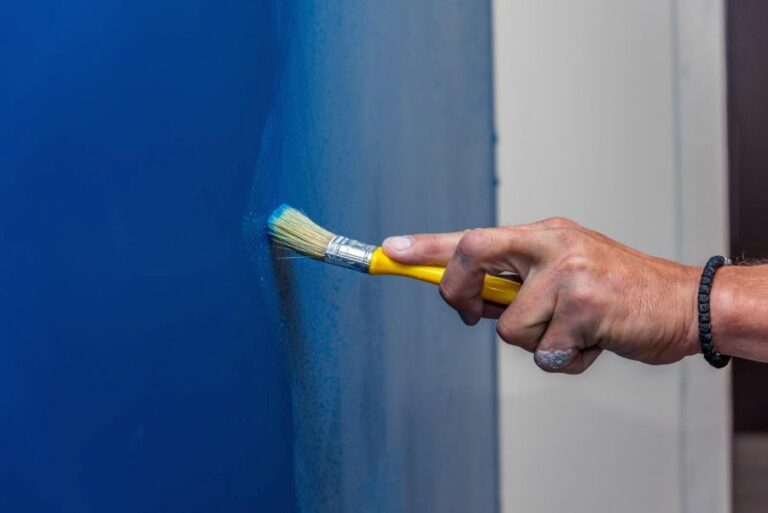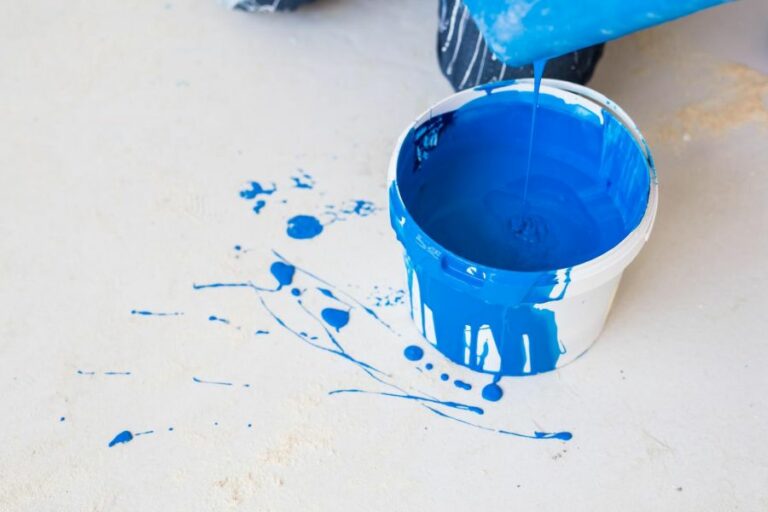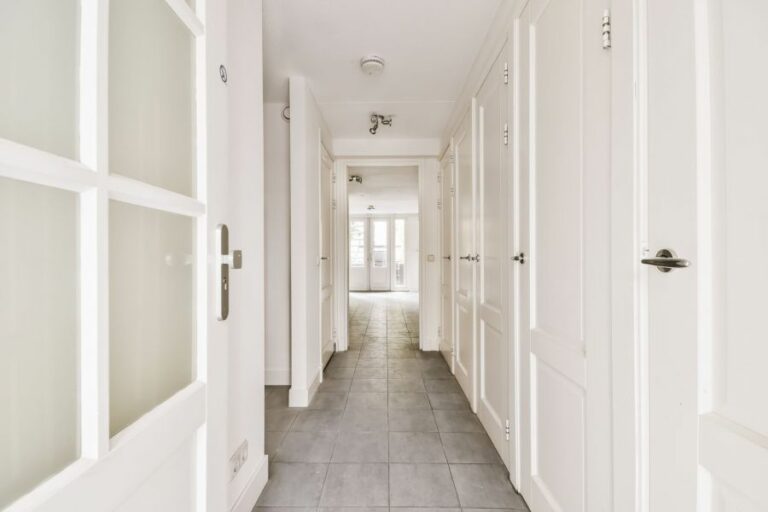Acrylic Paint For Indoor Walls, 25 Things You Should Know
Are you looking to refresh the look of your indoor space with a fresh coat of paint? Acrylic paint can be the perfect solution for taking your walls from bland to vibrant. With its wide range of colors and finishes, you can easily transform your home to fit your unique style, and I am here to help you navigate the best options for your living area.
Acrylic paint for indoor walls:>
Acrylic paint is a versatile, durable, and eco-friendly option for indoor wall painting. It can be applied to various surfaces, dries quickly, and has low volatile organic compound (VOC) emissions. Available in different sheens, acrylic paint requires proper application and maintenance for a long-lasting finish. Choose the appropriate paint, color, and tools for your project to achieve the desired result.

Discover the vibrant world of acrylic paint for indoor walls! Explore various creative techniques, color options, and surfaces to make your walls shine with personality. Dive into my expertly curated guide and elevate your interior design like never before! Keep reading for endless inspiration.
Contents
- 1 Interior Wall Acrylic Paint Solutions
- 2 Utilizing Acrylic Paint for Indoor Walls
- 3 Top Paint Choices for Interior Wall Surfaces
- 4 Advantages and Disadvantages of Acrylic Wall Paint
- 5 Comparing Acrylic Paint to Traditional Wall Paint
Interior Wall Acrylic Paint Solutions
• Introduction
Acrylic paint is an excellent choice for indoor wall painting due to its versatility, durability, and ease of use. This water-based paint is resistant to fading and dries quickly, making it an ideal option for professionals and DIY enthusiasts.
• Benefits of Acrylic Paint
– Versatility
Acrylic paint can be used on various surfaces, such as drywall, plaster, wood, and metal. Its versatility makes it popular for painting interior walls and surfaces in different settings, including residential, commercial, and artistic projects.
– Durability
Acrylic paint is known for its durability, as it is resistant to fading, scratching, and chipping. Unlike traditional oil-based paints, acrylic paint is less likely to crack or peel, ensuring your walls remain beautiful over time.
– Quick Drying Time
One of the key advantages of acrylic paint is its quick drying time. Typically, acrylic paint dries within 1-2 hours, depending on the thickness of the coat and the room temperature. This feature allows for shorter project timelines and less disruption in the space being painted.
– Low VOC Emissions
Acrylic paint produces lower levels of volatile organic compounds (VOCs) compared to oil-based paints. As VOCs have been linked to health issues such as respiratory irritation and headaches, opting for low-VOC acrylic paint can be a healthier choice for your home or work environment.
• Selecting the Right Acrylic Paint
– Evaluating the Sheen
Acrylic paint is available in different sheens, which can affect the appearance and functionality of your painted walls. Some common sheens for acrylic paint include:
- Matte: A low-gloss finish that provides a soft, subtle look. Ideal for living areas, bedrooms, and ceilings.
- Eggshell: A low to mid-gloss finish that offers a slight sheen. This finish is more durable than matte, making it a good option for hallways, children’s rooms, and kitchens.
- Satin: A mid-gloss finish with more durability than eggshell. Suitable for bathrooms, kitchens, and high-traffic areas.
- Semi-Gloss: Has a glossy appearance and high durability. Ideal for kitchens, bathrooms, and areas exposed to moisture or frequent cleaning.
– Considering the Surface
Before selecting the appropriate acrylic paint, it’s essential to consider the surface you are painting. For example, drywall requires a primer before painting to ensure proper adhesion and a smooth finish.
On the other hand, for surfaces like metal or wood, it’s crucial to use a specific paint and primer designed for these materials.
– Color Selection
When choosing a color for your indoor walls, consider factors such as the room’s size, lighting, and purpose. Lighter colors can make a small space appear larger, while darker colors may create a more intimate and cozy atmosphere.
Obtaining color samples and testing them on your walls can help you make the right decision for your space.
• Tools and Techniques for Applying Acrylic Paint
– Essential Tools
Before starting your painting project, gather the necessary tools, such as:
- Paintbrushes: Opt for synthetic bristle brushes, as they work well with acrylic paint
- Paint rollers: Choose a roller with a suitable nap (thickness) for your wall’s texture
- Paint tray and liners
- Drop cloths to protect your floors and furniture
- Painter’s tape to ensure clean edges
- Ladder or step stool if necessary
– Painting Tips
- Prep the Space: Remove any furniture or decor that could get in the way or be damaged during the painting process.
- Clean the Surface: Clean your walls with a mild soap and water solution to remove dirt, grime, or grease. Allow the surface to dry completely before painting.
- Apply Primer: A primer is necessary for certain surfaces and can help create a uniform finish. Apply a layer of primer with a roller or brush and allow it to dry according to manufacturer instructions.
- Paint the Edges: Using a paintbrush, carefully paint around the edges of the wall near the trim, baseboards, and outlets.
- Roll the Paint: Dip your roller in the paint tray and apply paint to your walls in a “W” or “M” pattern. Work in sections, ensuring that the edges remain wet to prevent visible lines.
- Apply Additional Coats: If necessary, apply additional coats of paint to achieve even coverage, allowing ample drying time between each coat.
• Acrylic Paint Maintenance
Taking care of your painted walls is essential to maintaining their beauty and longevity. For routine cleaning, use a soft cloth or sponge, dampened with water or a mild detergent, to wipe away dirt and stains gently. Avoid using harsh chemicals or abrasive materials, as they can damage the paint’s finish.
In high-traffic areas or rooms prone to dirt and grime, consider using a higher gloss paint finish, as these tend to be more durable and easier to clean.
To learn more about maintaining painted walls, visit the Paint Quality Institute for additional advice and resources.
• Conclusion
Acrylic paint is an excellent choice for indoor wall projects, given its versatility, durability, and low VOC levels.
By carefully selecting the right paint, sheen, and color for your space and following proper application and maintenance techniques, you can achieve a beautiful and long-lasting finish for your indoor walls.
Utilizing Acrylic Paint for Indoor Walls
• Understanding Acrylic Paint
Acrylic paint is a popular choice for various artistic and DIY purposes due to its versatility, quick drying time, and durability. This water-based paint is made from pigment particles suspended in an acrylic polymer emulsion, resulting in a paint that can adhere to a wide range of surfaces.
For a better understanding of acrylic paint, visit the Smithsonian’s Museum Conservation Institute’s information page on caring for acrylic paintings.
• Benefits of Using Acrylic Paint on Interior Walls
– Versatility and Customization
Acrylic paint works well on a wide range of surfaces, allowing you to create unique and interesting designs on interior walls. Additionally, since the paint can be easily mixed, you can create custom colors and finishes to achieve your desired look.
– Quick Drying Time
The quick drying time of acrylic paint is a significant advantage when working on interior walls. It allows you to finish projects faster, with less downtime waiting for the paint to dry. This can be especially useful when painting a large area or when applying multiple layers or colors.
– Durability and Longevity
Acrylic paint is very durable and resistant to fading, scratching, and water damage. This makes it an excellent option for interior walls, where these types of damage can occur. Acrylic paint also retains its color and finish for a long time, so your walls will look fresh and vibrant for years to come.
– Easy Clean-Up
One of the major advantages of using acrylic paint is that it cleans up easily with water. This means that you don’t have to worry about using harsh chemicals or solvents to clean your brushes and other painting tools, making the painting process much safer and more environmentally friendly.
• Preparing Interior Walls for Acrylic Paint
– Cleaning the Surface
Before applying acrylic paint to your interior walls, it’s crucial to clean the surface thoroughly to ensure proper adhesion.
This can be done by wiping the walls with a damp cloth or sponge and a mild detergent, followed by rinsing the surface with clean water. Make sure the walls are completely dry before you begin painting.
– Repairing Damages
Repair any damages, such as cracks, holes, or uneven surfaces, with a suitable filler or patching compound. Once the repairs are dry, sand the surface smoothly and ensure that it is free of dust and debris.
– Priming the Surface
Applying a primer to your interior walls can help provide a uniform surface for the acrylic paint to adhere better. It also helps to seal any stains and ensures a more even finish. Choose a primer specifically designed for use with acrylic paint and follow the manufacturer’s instructions for application.
• Applying Acrylic Paint to Interior Walls
– Choosing the Right Tools
Select appropriate tools, such as brushes, rollers, and edging tools, for your specific project. Using high-quality tools can help ensure a smoother, more professional-looking finish.
– Mixing and Thinning the Paint
When using acrylic paint on interior walls, it may be necessary to thin the paint to achieve the desired consistency. This can be done by adding a small amount of water or a suitable acrylic paint medium. Be sure to follow the paint manufacturer’s recommendations for the proper ratios.
– Painting Techniques
To achieve a professional-looking finish, apply the acrylic paint using the proper techniques for your chosen tools. For example, when using a roller, roll the paint in a “W” or “M” pattern; when using a brush, paint with smooth, even strokes, working in one direction.
– Protecting Your Work
After applying the acrylic paint and allowing it to dry completely, it’s a good idea to protect your work with a clear sealant or varnish. Many products are available specifically for use with acrylic paint, so choose one that suits your needs and follow the manufacturer’s instructions for application.
• Conclusion
In conclusion, using acrylic paint on interior walls is a versatile, durable, and efficient option. You can create stunning, long-lasting designs on your walls with the proper preparation and application techniques.
The quick drying time, easy clean-up, and longevity of the finish make acrylic paint an excellent choice for many interior painting projects.
For additional information on using acrylic paint, consider visiting the American Institute for Conservation to find educational resources and professional guidance.
Question | Answer |
|---|---|
Can you use acrylic paint on interior walls? | Yes, acrylic paint can be used on interior walls. It is durable, has low VOC (Volatile Organic Compounds), and dries quickly. However, it is recommended to use interior latex paint for better results and coverage. |
Top Paint Choices for Interior Wall Surfaces
Choosing the right paint for your interior walls is an essential aspect of ensuring the comfort, style, and durability of your living spaces. With a plethora of paint types available in the market, it becomes challenging to decide the best one for your needs.
• Water-Based Paints
Also referred to as latex or acrylic paints, water-based options are the most common types of interior wall paint. These paints consist of pigment and binder mixed with water, making them versatile and easy to use for various surfaces.
– Pros
Easy Cleanup and Low Odor
Water-based paints have a low volatile organic compound (VOC) content, emitting fewer harmful chemicals into the air. This makes them more environment-friendly and fitting for homes with children, pets, and people sensitive to strong odors.
Quick Drying
These paints tend to dry quickly which allows for faster recoating or touch-ups, cutting down on the overall project time.
Non-Yellowing
Less prone to yellowing over time, water-based paints maintain their original color longer compared to oil-based alternatives.
Expert Recommendation: For general interior wall applications, water-based paints offer great results for a wide range of surfaces.
– Cons
Less Durable
Water-based paints may not be the best choice for high-traffic areas or surfaces prone to regular wear and tear since they can lose gloss and are not as robust.
Poor Adhesion
If applied over a glossy surface or a surface previously painted with oil-based paint, water-based paints may not adhere correctly, resulting in peeling and chipping.
• Oil-Based Paints
Also known as alkyd or solvent-based paint, oil-based options provide a durable and glossy finish for interior walls. They consist of resins dissolved in oil, which evaporates over time, leaving behind a hard and resilient coating.
– Pros
Durability
Oil-based paints create a tough, long-lasting finish, making them perfect for surfaces that require frequent cleaning or experience constant wear and tear.
Smoother Finish
As these paints dry slower, they provide ample time for surface-leveling resulting in fewer visible brush strokes or roller marks, creating a professional and smooth finish.
Expert Recommendation: Use oil-based paints for trims, doors, and high-traffic areas where a resilient, easy-to-clean finish is needed.
– Cons
Strong Odor
Oil-based paints contain a high level of VOCs which cause a strong smell that can linger for days, requiring proper ventilation during application.
Difficult Cleanup
Cleaning brushes and rollers after using oil-based paints is time-consuming, as it necessitates the use of mineral spirits or paint thinner.
• Paint Sheens/Finishes
The sheen or finish of the paint largely impacts its visual appeal and durability. Here’s a rundown of the different sheen options available:
– Flat/Matte Finish
Best suited for: Ceilings or low-traffic areas that do not require frequent cleaning.
Pros
- Hides imperfections well.
- Non-reflective, which reduces glare.
Cons
- Less resistant to stains and moisture.
- Difficult to clean.
– Eggshell Finish
Best suited for: Living rooms, bedrooms, and dining rooms.
Pros
- Slight gloss provides an elegant finish.
- More forgiving of surface imperfections compared to higher sheen paints.
Cons
- Less washable than satin or semi-gloss.
- May require more than one coat to achieve even coverage.
– Satin Finish
Best suited for: Kitchens, hallways, and children’s rooms.
Pros
- Smooth, pearl-like finish.
- Easy to clean.
- More stain-resistant than flat or eggshell.
Cons
- Imperfections might be more visible.
- Can be difficult to touch up.
– Semi-Gloss Finish
Best suited for: Trim, doors, and windows.
Pros
- Highly washable and stain-resistant.
- Reflects light well, providing a bright appearance.
Cons
- Will make imperfections more noticeable.
– Gloss Finish
Best suited for: Cabinetry, furniture, and accents.
Pros
- Extremely durable and easy to clean.
- Provides a high shine and glass-like appearance.
Cons
- Makes surface imperfections very visible.
• Conclusion
Selecting the right paint for your interior walls is a personal choice based on your preferences for durability, sheen, and ease of application.
As a general rule, water-based paints with satin or eggshell finishes are best suited for most interior walls, whereas oil-based paints with semi-gloss or gloss finishes are ideal for surfaces requiring high durability and shine.
Take your time to analyze your specific needs and pick the right paint type and finish to transform your living spaces into a haven of comfort and style.
Type of Paint | Pros | Cons |
|---|---|---|
Matte Paint | Hides imperfections, Minimal glare, Easy touch-ups | Requires multiple coats, Difficult to clean |
Eggshell Paint | Smooth finish, Some washability, Less porous | Requires more coats than satin, Not suitable for high-traffic areas |
Satin Paint | Easy to clean, Durable, Elegant finish | May show imperfections, Slightly glossy |
Semi-gloss Paint | Durable, Easy to clean, Good for high-traffic areas | Glossy appearance, May show imperfections, Not suitable for all rooms |
Gloss Paint | Highly durable , Easy to clean, Excellent for trim and doors | Very glossy, Shows imperfections, Not ideal for walls |
Advantages and Disadvantages of Acrylic Wall Paint
When it comes to painting walls, we generally choose between oil-based and water-based (acrylic) paints. Both have their advantages and disadvantages. Choosing the right one depends on various factors, such as personal preference, budget, and purpose.
• Pro: Water-based Composition
One of the major benefits of acrylic paint is its water-based composition. This allows for easy cleanup with soap and water, unlike oil-based paint, which requires strong chemicals for cleanup.
Moreover, since water-based paint dries much faster, it significantly reduces the waiting time between coats, making your painting project more efficient.
• Pro: Low VOCs
Acrylic wall paint contains low levels of volatile organic compounds (VOCs). VOCs are harmful chemicals found in many products, including paints. These chemicals contribute to air pollution and can cause harmful short-term and long-term health effects.
By choosing acrylic wall paint, you are reducing your exposure to these harmful chemicals and making an eco-friendly choice. Learn more about low-VOC paints from the United States Environmental Protection Agency (EPA).
• Pro: Durability and Adhesion
Acrylic wall paint is known for its durability and adhesion. It adheres well to a variety of surfaces and resists damage from humidity, UV rays, and temperature changes. This makes it ideal not only for indoor use but also for exterior surfaces.
When applied properly, acrylic wall paint can create a long-lasting, attractive finish that is easy to maintain.
• Pro: Versatility
One of the main reasons people choose acrylic wall paint is its versatility. It can be easily mixed with various colorants and additives to create different effects and finishes. The paint can be thinned down to create a translucent layer or built up for a more opaque finish.
Acrylic paint is also suitable for different methods, such as glazing, stippling, or blending.
• Pro: Easy Application
Acrylic wall paint is known for its easy application, making it a perfect choice for both beginners and experienced painters. The paint can be applied with a brush, roller, or sprayer, depending on the desired effect. With proper surface preparation, you can achieve a smooth, even finish without the need for professional help.
• Con: Less Opacity
One of the drawbacks of acrylic wall paint is that it often has less opacity compared to oil-based paint. This means that you may need to apply multiple coats to achieve your desired color and coverage.
However, considering that acrylic paint dries faster, applying additional coats is generally less time-consuming than waiting for an oil-based paint to dry.
• Con: Limited Blending Time
Because acrylic paint dries so quickly, it can be challenging to blend and manipulate the paint on the wall. This characteristic makes creating smooth gradients or soft edges difficult, which may not be ideal for certain painting styles or techniques.
However, additives and retarders can extend the acrylic paint’s working time, allowing for more blending.
• Con: Surface Preparation
Acrylic wall paint may require thorough surface preparation to achieve the desired result. This means that surfaces should be clean, free of any loose debris, and properly primed for paint adhesion. Skipping or cutting corners on surface preparation may result in paint peeling or chipping over time.
However, thorough preparation is essential for any painting project, regardless of the type of paint used.
• Con: Tendency to Crack
While acrylic paint is generally durable, it may have a tendency to crack on certain surfaces or in extreme conditions. As acrylic paint is less flexible than oil-based paint, it can be less forgiving when applied to surfaces that are subjected to regular expansion and contraction.
In such cases, using a suitable primer or undercoat can help mitigate this issue.
• Conclusion
As you can see, acrylic wall paint offers numerous advantages and some disadvantages. The benefits of fast drying time, low VOCs, ease of application, and versatility make it an attractive choice for painting projects.
However, be aware of its limitations, such as reduced blending time, the need for thorough surface preparation, and a tendency to crack under specific conditions. Overall, the decision will depend largely on your personal preference and the specific requirements of your painting project.
Remember that proper technique and quality materials are critical for achieving an excellent result. Take the time to learn about the painting process and invest in the right tools and materials for the job. Happy painting!
Comparing Acrylic Paint to Traditional Wall Paint
When working on a painting project, whether it’s a canvas artwork or a home improvement task, choosing the right type of paint is crucial to achieving the desired outcome.
Acrylic paint and wall paint are two common types of paint that people frequently use, but there is often confusion about the differences between these types of paint.
• The Composition of Acrylic Paint
Acrylic paint is a water-based paint that is made from a mixture of pigment, acrylic polymer emulsion, and additional additives.
This type of paint is commonly used in artwork and craft projects because of its versatility and ability to be applied on various surfaces such as canvas, paper, wood, and fabric, among others.
Acrylic paint is known for its quick-drying property, vibrant colors, and the ability to be easily thinned and cleaned with water.
– Advantages of Acrylic Paint
- Fast-drying time: This allows multiple layers of paint to be applied in a short period of time, making it ideal for artwork and quick touch-ups on surfaces.
- Flexibility: Acrylic paint is flexible and resistant to cracking, which is beneficial when applied to surfaces that may undergo temperature and humidity changes.
- Vibrant colors: Acrylic paint offers a wide range of colors, which can create dynamic and colorful works of art.
- Water-resistant: Once acrylic paint dries, it becomes water-resistant and increases the durability of the painted surface.
• The Composition of Wall Paint
Wall paint, also known as interior or exterior house paint, is specifically designed for painting the walls and ceilings in homes and buildings. It is typically made from a mixture of pigment, binder (usually acrylic or latex-based), and solvents (water or oil-based).
Wall paint comes in various finishes, including flat, matte, eggshell, satin, semigloss, and gloss. The type of finish chosen will determine the look and durability of the painted surface, as well as the level of resistance it provides against stains, moisture, and wear.
– Advantages of Wall Paint
- Formulated for large surfaces: Wall paint is designed to cover large, flat surfaces, while acrylic paint is more suited for smaller, detailed work.
- Durability: Wall paint is formulated to withstand daily wear and tear, making it a durable and long-lasting option for interior and exterior walls.
- Moisture and stain resistance: Depending on the finish, wall paint can offer varying levels of resistance against moisture, stains, and dirt, which helps to maintain a clean and pristine appearance.
- Smooth and even application: Wall paint is formulated to provide a consistent, even application on walls and ceilings, ensuring an even and professional-looking finish.
• Comparing Acrylic Paint and Wall Paint
Though acrylic paint and wall paint share some similar components, they are not the same and tend to serve different purposes.
– Differences
- Primary uses: Acrylic paint is primarily used for artwork, crafts, and small touch-ups, while wall paint is specifically designed for painting walls and ceilings in residential and commercial spaces.
- Finishes: Wall paint offers a wider range of finishes compared to acrylic paint, allowing for better control in achieving the desired appearance and durability for walls and ceilings.
- Application: Wall paint is generally easier to apply on large surfaces and provides a smoother, more consistent finish, while acrylic paint is better suited for detailed work.
- Price: Acrylic paint can be more expensive than wall paint due to its composition and the vibrancy of the colors.
Despite these differences, it is possible to use acrylic paint on walls and vice versa in some cases. Here are some guidelines and recommendations based on personal experience:
– Using Acrylic Paint as Wall Paint
When using acrylic paint as wall paint, consider the following points:
- Use a larger, flat paintbrush or a paint roller for easier application and to cover a larger surface area.
- Be prepared for multiple coats, as acrylic paint may not provide the same coverage as wall paint.
- Take into account the fast-drying time, as it may affect blending and touch-ups.
– Using Wall Paint for Art Projects
When using wall paint for art projects, consider the following:
- Use a primer for better adhesion on surfaces like canvas or wood.
- Take note that wall paint may not be as vibrant or suitable for fine details as acrylic paint.
- Consider the size of your project, as purchasing larger quantities of wall paint may not be necessary for small-scale art projects.
• Conclusion
In conclusion, acrylic paint and wall paint are not the same and are designed for different purposes, but they can be used interchangeably in certain situations. To achieve the best results, consider the desired outcome, the surface being painted, and the type of paint that best suits the project’s requirements.







